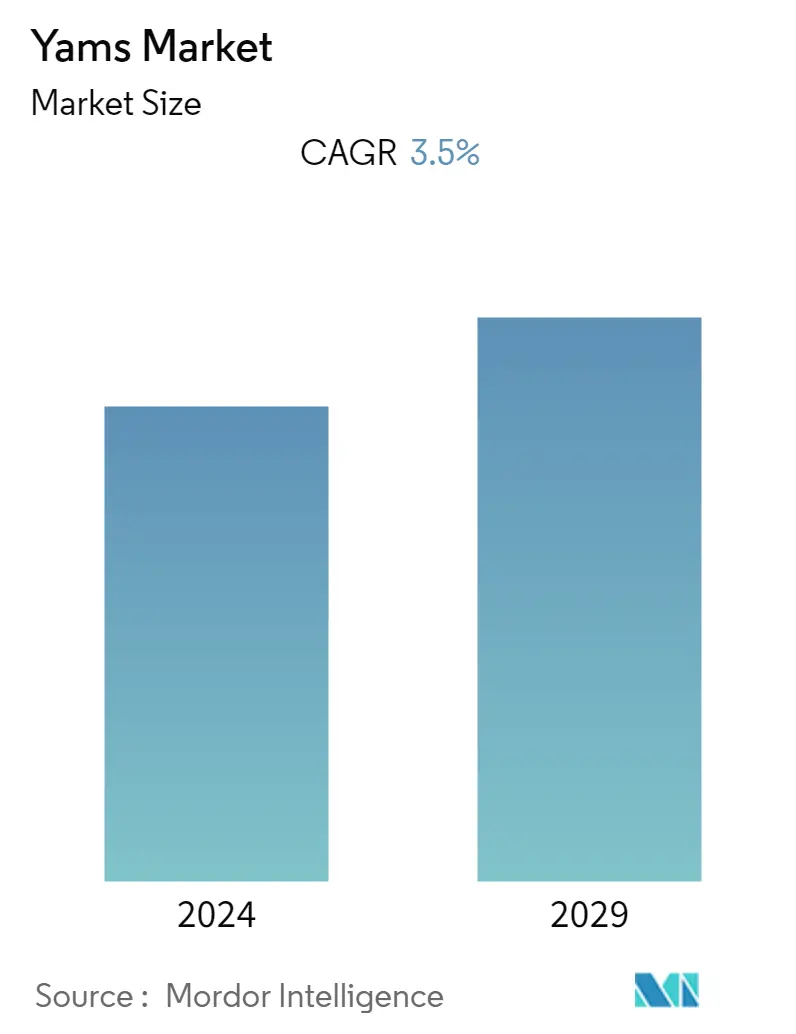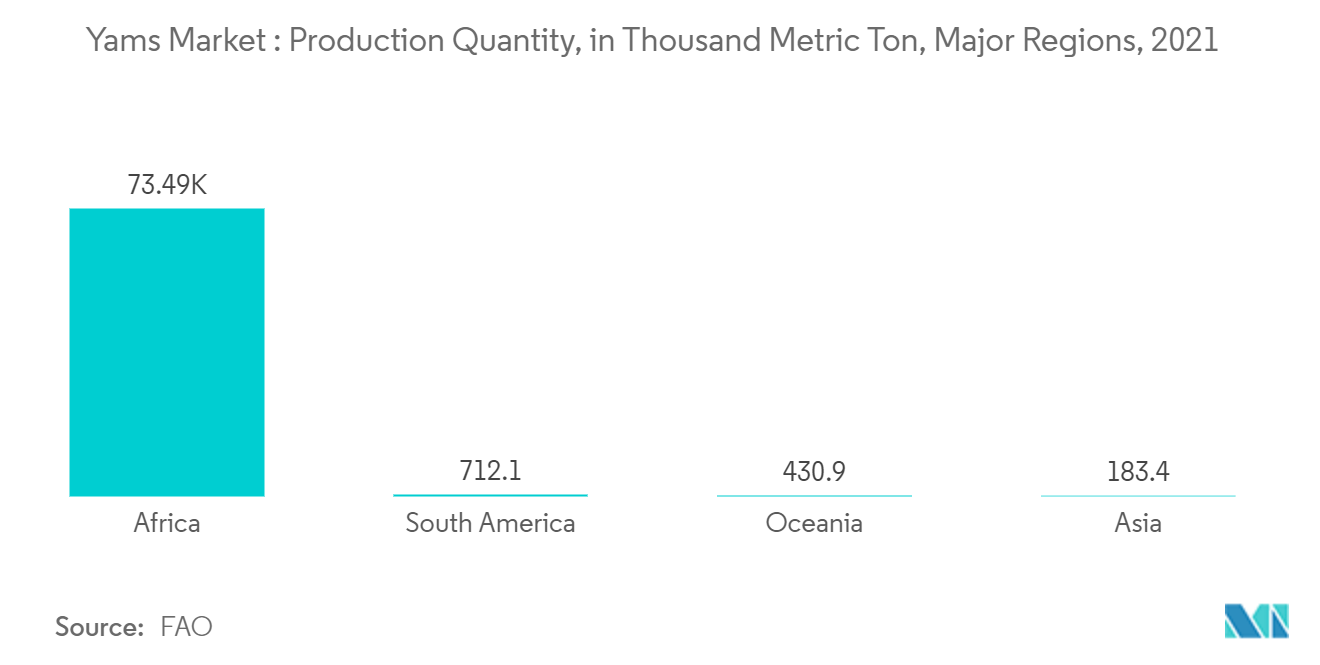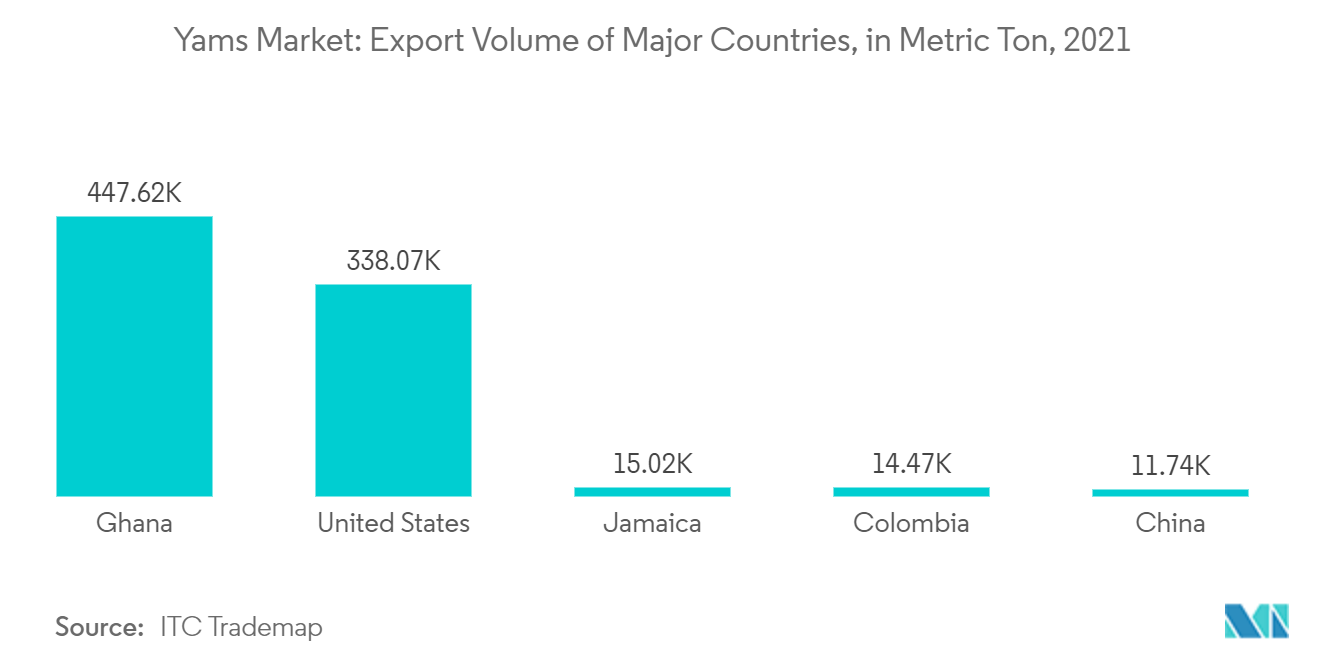Yams Market Size

| Study Period | 2019 - 2029 |
| Base Year For Estimation | 2023 |
| Forecast Data Period | 2024 - 2029 |
| CAGR | 3.50 % |
| Fastest Growing Market | South America |
| Largest Market | Africa |
Major Players*Disclaimer: Major Players sorted in no particular order |
Yams Market Analysis
The Yams market is projected to register a CAGR of 3.5% over the forecast period.
- Yams are starchy staples in the form of large tubers produced by annual and perennial vines grown in Africa, the United States, the Caribbean, South Pacific, and Asia. White Guinea yam, D. rotundata, is the most critical species in western and Central Africa. Water yam, D. alata, the second most cultivated species, originated from Asia and is the most widely distributed species in the world. Consumers' demand for yam is generally very high globally, and yam cultivation is profitable despite high production costs. Yam processors are reluctant to invest in new processing capacity without a steady supply of high-quality tubers.
- The increasing awareness among consumers of yams' health benefits increases global demand. Yams are nutrient-rich and contain vitamin C, magnesium, potassium, manganese, copper, and fiber. Yams also help in improving brain functions and relieving arthritis symptoms. They contain a unique compound called diosgenin, which promotes neuron growth, enhances brain function, and inhibits the progression of both osteoporosis arthritis and rheumatoid arthritis. Yams also help to maintain cholesterol levels.
- Yam tubers comprise about 21% dietary fiber and are rich in carbohydrates, vitamin C, and essential minerals. Worldwide annual consumption of yams is 18 million tons, with 15 million in West Africa in 2021. Annual consumption in West Africa is 61 kilograms per capita in the year 2021. Yams are boiled, roasted, baked, or fried. In Africa, they are also mashed into a sticky paste or dough after boiling.
Yams Market Trends
This section covers the major market trends shaping the Yams Market according to our research experts:
Rising Health Benefits of Yams across the Globe
- Yams are a kind of tuber vegetable rich in fiber, protein, vitamins, minerals, magnesium, potassium, copper, folate, and thiamine which are important for supporting bone health, growth, metabolism, and heart function.
- Yams contain a unique compound called diosgenin, which has been found to promote neuron growth and enhance brain function. Additionally, it improves hormonal balance to treat menopause, PMS, infertility, and low libido in females, owing to greater yams production across the globe, which will propel the demand for yams in the market.
- Yams are grown by planting pieces of tuber or small whole tubers ('seed yams') saved from the previous season. Small-scale farmers, the majority of producers, often intercrop yams with cereals and vegetables.
- Due to declining soil fertility, increasing pest pressures, and the high cost of labor, yam production is declining in some of the traditional producing regions. To eradicate this farming culture, the growers are modulating precision agricultural and integrated pest management (IPM) techniques to stabilize crop productivity in the regions.
- According to the Food and Agricultural Organization (FAO), countries like Nigeria and Ghana of the African region holds a significant share in the production as yam cultivation started 11,000 years ago and is one of the primary commodity in the region. Benin, Cameroon, Central African Republic, Côte d'Ivoire, Chad, and Ethiopia, are some of the major producers of yam in the world.
- According to the International Institute of Tropical Agriculture (IITA), most of the world's production comes from West Africa, representing 94%, with Nigeria alone producing 71% in 2021.

Rising Export Trend for Yams
- According to the ITC Trademap, in 2021, Ghana, the United States, Jamaica, Colombia, China, Costa Rica, and India were the major yam exporters globally, accounting for 447,6200 metric tons valued at USD 199,179 thousand.
- Yam tubers comprise about 21% dietary fiber and are rich in carbohydrates, vitamin C, and essential minerals. Most of the African yam produced is consumed domestically, accounting for 15 million tons out of 18 million tons worldwide.
- Ghana accounts for a major share of 24.4% export of yam, followed by the United States (20.1%) and Jamaica (11.0%). According to the Ghana Export Promotion Authority in 2019, the United Kingdom was the main export destination for yams from Ghana valued at USD 5,576 thousand, closely followed by the United States with USD 3,225 thousand. Together, these markets comprise 69.2% of the total Ghanaian export value, 27,282 metric tons in 2019. The increased demand for yams globally is expected to increase the export opportunity.

Yams Market News
- August 2022: Fiji Yam Farmers Association (FYFA) association, an affiliate of the Fiji Crop and Livestock Council (FCLC), serves the needs of yam farmers and provides a channel of communication for sale and reproduction.
- May 2021: Yam farmers in the Wenchi Municipality of the Bono region, Ghana, adopted the best scientific production methods such as trellised and ridging planting technology to enhance their competitiveness in the global market.
- April 2021: The farmers from Murang'a county of Kenya opted to uproot their coffee bushes and embarked on aerial yam farming, a unique crop in the region to supply adequate water for irrigation during the dry period with less labor-intensive expenses.
Yams Market Report - Table of Contents
1. INTRODUCTION
- 1.1 Study Assumptions & Market Definition
- 1.2 Scope of the Study
2. RESEARCH METHODOLOGY
3. EXECUTIVE SUMMARY
4. MARKET DYNAMICS
- 4.1 Market Overview
- 4.2 Market Drivers
- 4.3 Market Restraints
- 4.4 Value Chain Analysis
5. MARKET SEGMENTATION (Production Analysis in Volume, Consumption Analysis by Volume and Value, Import Analysis by Value and Volume, Export Analysis by Value and Volume, and Price Trend Analysis)
-
5.1 Geography
- 5.1.1 North America
- 5.1.1.1 United States
- 5.1.1.2 Canada
- 5.1.1.3 Mexico
- 5.1.1.4 Rest of North America
- 5.1.2 Europe
- 5.1.2.1 Germany
- 5.1.2.2 United Kingdom
- 5.1.2.3 France
- 5.1.2.4 Russia
- 5.1.2.5 Spain
- 5.1.2.6 Rest of Europe
- 5.1.3 Asia Pacific
- 5.1.3.1 India
- 5.1.3.2 China
- 5.1.3.3 Japan
- 5.1.3.4 Rest of Asia Pacific
- 5.1.4 South America
- 5.1.4.1 Brazil
- 5.1.4.2 Argentina
- 5.1.4.3 Rest of South America
- 5.1.5 Middle East and Africa
- 5.1.5.1 Nigeria
- 5.1.5.2 Ghana
- 5.1.5.3 Rest of Middle East and Africa
6. MARKET OPPORTUNITIES AND FUTURE TRENDS
** Subject To AvailablityYams Industry Segmentation
Yams are perennial herbaceous vines cultivated for the consumption of their starchy tubers in many temperate and tropical regions, especially in West Africa, South America and the Caribbean, Asia, and Oceania.
The yams market is segmented by geography into North America, Europe, Asia-Pacific, South America, and the Middle East and Africa. The report offers an analysis of production (volume), consumption (value and volume), import (value and volume), export (value and volume), and price trend analysis.
The report offers market size and forecasts in terms of value (USD thousand) and volume (metric ton) for all the above segments.
| Geography | North America | United States |
| Canada | ||
| Mexico | ||
| Rest of North America | ||
| Geography | Europe | Germany |
| United Kingdom | ||
| France | ||
| Russia | ||
| Spain | ||
| Rest of Europe | ||
| Geography | Asia Pacific | India |
| China | ||
| Japan | ||
| Rest of Asia Pacific | ||
| Geography | South America | Brazil |
| Argentina | ||
| Rest of South America | ||
| Geography | Middle East and Africa | Nigeria |
| Ghana | ||
| Rest of Middle East and Africa |
Yams Market Research FAQs
What is the current Yams Market size?
The Yams Market is projected to register a CAGR of 3.5% during the forecast period (2024-2029)
Which is the fastest growing region in Yams Market?
South America is estimated to grow at the highest CAGR over the forecast period (2024-2029).
Which region has the biggest share in Yams Market?
In 2024, the Africa accounts for the largest market share in Yams Market.
What years does this Yams Market cover?
The report covers the Yams Market historical market size for years: 2019, 2020, 2021, 2022 and 2023. The report also forecasts the Yams Market size for years: 2024, 2025, 2026, 2027, 2028 and 2029.
Yams Industry Report
Statistics for the 2024 Yams market share, size and revenue growth rate, created by Mordor Intelligence™ Industry Reports. Yams analysis includes a market forecast outlook to 2029 and historical overview. Get a sample of this industry analysis as a free report PDF download.



